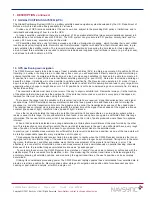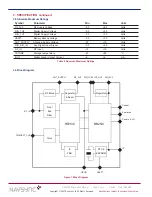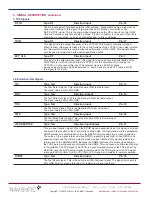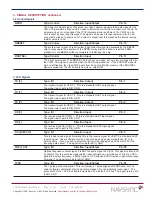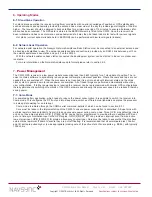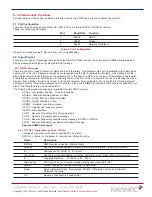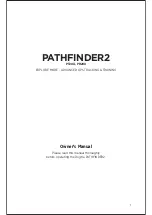
Copyright ©2007 NavSync Ltd.All Rights Reserved
Specifications subject to change without notice.
CW25 Software User Manual
Page
5 of 50
Rev 03
Date: 06/16/08
1. DESCRIPTION continued
1.2 GLOBAL POSITIONING SYSTEM (GPS)
The Global Positioning System (GPS) is a military satellite based navigation system developed by the U.S. Department of
Defence, which is also made freely available to civil users.
Civilian use of GPS is made available at the user’s own risk, subject to the prevailing DoD policy or limitations, and to
individuals understanding of how to use the GPS.
In today’s satellite constellation there are a minimum of 24 operational satellites (plus several operational spares) in 6
orbital planes, at an altitude of about 22,000 km. The GPS system can give accurate 3-D position, velocity, time, and fre-
quency, 24 hours a day, anywhere around the world.
GPS satellites transmit a code for timing purposes, and also a ‘Navigation message’, which includes their exact orbital
location and system integrity data. Receivers use this information, together with data from their internal almanacs, to pre-
cisely establish the satellite location. The receiver determines position by measuring the time taken for these signals to
arrive. At least three satellites are required to determine latitude and longitude if your altitude is known (e.g. a ship at sea),
and at least a fourth to obtain a 3-D fix.
1.3 GPS positioning and navigation
The CW25 Receiver needs to be able to see at least 4 satellite vehicles (SV’s) to obtain an accurate 3-D position fix. When
travelling in a valley or built-up area, or under heavy tree cover, you will experience difficulty acquiring and maintaining a
coherent satellite lock. Complete satellite lock may be lost, or only enough satellites (3) tracked to be able to compute a 2-
D position fix or even a poor 3D fix due to insufficient satellite geometry (i.e. poor DOP). Note also, that inside a building or
beneath a bridge, it probably will not be possible to update a position fix. The Receiver can operate in 2-D mode if it goes
down to seeing only 3 satellites by assuming its height remains constant. But this assumption can lead to very large errors,
especially when a change in height does occur. A 2-D position fix is not to be considered a good or accurate fix; it is simply
“better than nothing”.
The receiver’s antenna must have a clear view of the sky to acquire satellite lock. Remember always, it is the location
of the antenna that will be given as the position fix. If the antenna is mounted on a vehicle, survey pole, or backpack, al-
lowance for this must be made when using the solution.
To measure the range from the satellite to the receiver, two criteria are required: signal transmission time, and signal
reception time. All GPS satellites have several atomic clocks that keep precise time and these are used to time-tag the
message (i.e. code the transmission time onto the signal) and to control the transmission sequence of the coded signal.
The receiver has an internal clock to precisely identify the arrival time of the signal. Transit speed of the signal is a known
constant (the speed of light), therefore: time x speed of light = distance.
Once the receiver calculates the range to a satellite, it knows that it lies somewhere on an imaginary sphere whose
radius is equal to this range. If a second satellite is then found, a second sphere can again be calculated from this range
information. The receiver will now know that it lies somewhere on the circle of points produced where these two spheres
intersect.
When a third satellite is detected and a range determined, a third sphere would intersect the area formed by the other
two. This intersection occurs at just two points. The correct point is apparent to the user, who will at least have a very rough
idea of position. A fourth satellite is then used to synchronise the receiver clock to the satellite clocks.
In practice, just 4 satellite measurements are sufficient for the receiver to determine a position, as one of the two points will
be totally unreasonable (possibly many kilometres out into space).
This assumes the satellite and receiver timing to be identical. In reality, when the CW25 Receiver compares the incom-
ing signal with its own internal copy of the code and clock, the two will no longer be synchronised. Timing error in the satel-
lite clocks, the Receiver, and other anomalies, mean that the measurement of the signals transit time is in error. This
effectively, is a constant for all satellites, since each measurement is made simultaneously on parallel tracking channels.
Because of this, the resultant ranges calculated are known as “pseudo-ranges”.
To overcome these errors, the CW25 Receiver then matches or “skews” its own code to become synchronous with the
satellite signal. This is repeated for all satellites in turn, thus measuring the relative transit times of individual signals. By
accurately knowing all satellite positions, and measuring the signal transit times, the user’s position can be accurately
determined.
Utilizing its considerable processing power, the CW25 Receiver rapidly updates these calculations from satellite data to
provide a real time position fix. Memory options allow storage of navigation and position data for subsequent post-pro-
cessing or post-mission analysis, all within a single unit.





